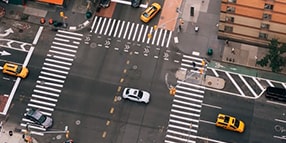-
Black spots...accidents waiting to happen.
November 05, 2019


Black spots...accidents waiting to happen.
When we talk about black spots, it may evoke visions of 101 Dalmatian puppies frolicking carefree in sun-drenched fields that are sure to bring a smile to your face. For some, however, black spots do not flood them with an endorphin rush of happy memories. To some, it haunts them, pains them and grieves them, while some are no longer with us. These are all victims of serious accidents due to black spots on our roads. The only memories they recall are losing control, airbags exploding, bones cracking, metal crushing, glass smashing, unbearable pain, blood, sirens and emergency crews.
“It’s like a horrible car accident - you’re never the same after that.
It’s something that you’ll think about every day for the
rest of your life..”
- - Wayne Coyne -What is a black spot?
By definition, a black spot is a place or area marked by inherent trouble or concern. When it comes to road safety, a black spot is a portion of a roadway that has been earmarked as being significantly accident-prone, one where road traffic accidents have historically been concentrated. They may have occurred for a variety of reasons, such as:
- Sharp corners in a straight road, concealing oncoming traffic
- Hills or winding roads that limit visibility ahead
- Hidden junctions and intersections
- Poor or concealed warning signs
One of the fundamental problems linked to road injuries and deaths are the existence of black spots. Around the globe, each country has its method of identifying and defining a black spot. In essence, however, the message is similar, it is a road location that has a record of a large number of crashes or fatalities. Three factors determine a black spot.
- 1. Accident rate
- 2. Accident frequency
- 3. Accident severity
Black spots occur in both urban and rural areas. Consider this, you are driving on a rural road and the road and area ahead seem to disappear. That is often considered a black spot. Unexpected sharp corners, hills, winding paths, hidden junctions and poor or concealed warning signs can all contribute to black spots. Without clear road direction, drivers are caught off guard by the changes in the road.
Black Spot reduction has been a priority for government transportation agencies in recent years. Several countries have black spots reduction initiatives with target dates to reduce crashes and fatalities in identified black spots. In some cases, special funding or grant programs exist to implement countermeasures in black spots.
Black spot identification.
Motor vehicle crashes are multi-causal events and can be associated with one of, or a mixture, of three factors - the road user, the road environment, and the vehicle. When it comes to black spots, the concerns are usually linked to the specific attributes of the road environment. Motorists are forced to continually juggle their driving standards to meet the ever-changing demands of the road conditions and their surroundings. Although the term black spot suggests a precise location, it is also often used to refer to sections of high-risk roads. Black spot locations have reasonably high driver performance requirements in terms of skills and concentration when capabilities fall below those essential levels accidents are likely to occur. Governments around the globe recognise the need to reduce the social and economic costs of road trauma by improving the physical condition and management of identified black spots. Black spot reduction programs exist in many countries, with each having varying levels of funding and commitment. These projects aim to modify the road environment at black spot sites to reduce the performance demands on the driver, thereby minimising the likelihood of a crash.
Here in Australia, the Department of Infrastructure has committed $110 million per year until 2023 to reducing black spots as part of their National Road Safety Action Plan. Funding is mainly available for the treatment of black spot sites, or road lengths, with a proven history of crashes. The prerequisite of a history of crashes stipulates that those sites that have a persistent problem are slated first for treatment. However, the program also recognises that there are road locations deemed as ‘accidents waiting to happen’, this provides the contingency for proactive safety works, to be conducted, before casualties occur. In Australia’s program, anyone can nominate a black spot location for improvement: state governments, local councils, community groups, industries and individuals.
Common types of black spots on our roads.

Accident black spots
Although there is no universally accepted definition of a black spot, these locations will in general be described as high-risk accident locations.

Sharp curves
Roads with sharp curves and therefore a small curve radius are a primary indicator of the potential for fatal and serious injury crashes1.

Rural Roads
With the high frequency of unexpected sharp corners, hills, winding roads, hidden junctions and higher speeds, accident rates for fatal and incapacitating injuries on rural roads exceed those of functional roadways.

Intersections
Intersections are the meeting places for vehicles and pedestrians dispersing and converging in several branches and directions, resulting in accident-prone black spots.

School zones
Heavy concentration of vehicle traffic, pedestrians, and bicycles in short periods of time before and after school hours make school zones susceptible to black spots.

Construction zones
Workers on the road are at greater risk for being hit by passing motorists who may be confused or distracted by the altered conditions.
Using science to turn black spots into bright spots.
Driving at night can be difficult – especially on poorly-lit rural roads with unexpected twists and turns. More visible signs result in lower accident rates. Studies have found that where more visible signs are installed, crash numbers have fallen 25 to 46% in 3 to 6 years2. Globally, the World Health Organization (WHO) notes in their Road traffic injuries fact sheet that “the lives of approximately 1.35 million people are cut short as a result of a road traffic crash and between 20 and 50 million more people suffer non-fatal injuries, with many incurring a disability as a result of their injury.3” Conditions that create these statistics may, in part, be addressed through retroreflective technology that helps to increase safety in high-risk black spots locations. Retroreflective sheeting and pavement marking technology are ideal for ensuring maximum reflectivity on dark roads. Advances in retroreflective sheeting have resulted in signage that reflects 58% of the light back toward the driver – almost quadrupling road signs’ overall brightness from encapsulated glass beads that reflect 14% of the light back to the source.
At 3M, we believe crashes can be prevented. For over 75 years, we’ve been applying our science to push the boundaries of traffic safety. We’re proud to provide solutions through the design of systems, services and high-performance materials that will help create a safer future for drivers everywhere. By using science to create reflective signage that works to turn black spots into bright spots, 3M aims to reduce serious roadway crashes as we work towards the goal of stabilising and reducing the level of road traffic fatalities around the world.
3M solutions to common types of black spots
3M has a wide range of solutions that can help make black spots safer. During the day, and especially at night, 3M™ Diamond Grade™ DG3 Reflective Sheeting can make a difference by making signage brighter and more visible. Innovative full-cube prismatic technology enables reflective sheeting with the highest optical efficiency. Full-cube sheeting returns more light to drivers across a range of vehicle types and sign geometries. Brighter signs improve safety by giving drivers more time to react. 3M fluorescent technology, coupled with highly retroreflective sheeting, provides increased safety in difficult driving situations encountered in the diagram below, as well as in low-light conditions, such as dawn and dusk.

Seeing is believing...3M Science of Advanced Signs Workshop.

Driver safety is our top priority, with the highest luminance values at the distance that matters most, 3M™ Diamond Grade™ DG3 Sheeting helps to reduce crashes and fatalities. To see first hand the power of how better visibility signage can increase safety, register for an in-office demonstration. We would love to come and see you and your colleagues and run a workshop around the Science of Advanced Signage. We can tailor the workshop around any or all of the topics listed below:
- 1. Critical roles of traffic signage
- 2. Science of retro reflectivity
- 3. Science of fluorescence
- 4. Human factors affecting sign visibility
- 5. Environmental factors affecting sign performance
- 6. Do sign upgrades improve safety?
- 7. How to apply best practice in traffic signs
Register for the
workshop today!Reflective signage and pavement markings offer countries more affordable opportunities to reduce black spots on high-accident roads, help to reduce roadway crashes, and contribute to the progress being made by the United Nations, World Health Organization and country governments to stabilise and reduce road traffic fatalities around the world. For more information about reflective sign sheeting and performance levels to meet the needs of your specific application, view our Traffic Signage brochure, explore our website, or contact your 3M Transportation Safety Expert.
References:
- ‘Highway Safety Benefit–Cost Analysis Guide’, FHWA Safety Program, https://safety.fhwa.dot.gov/hsip/docs/fhwasa18001.pdf.
- Ripley, D. A., Howard R. Green Company, ITE AB04H313, Quantifying the Safety Benefits of Traffic Control Devices — Benefit-Cost Analysis of Traffic Sign Upgrades, 2005 Mid-Continent Transportation Research Symposium Proceedings.
- World Health Organization (WHO), Road traffic injuries fact sheet, accessed September 23, 2019.
